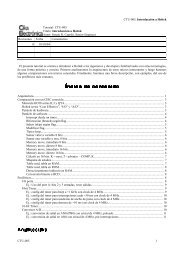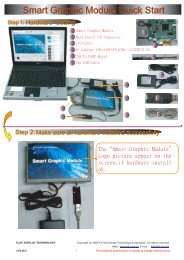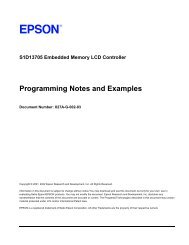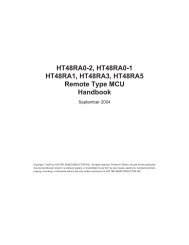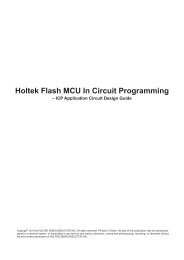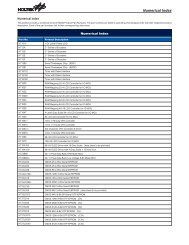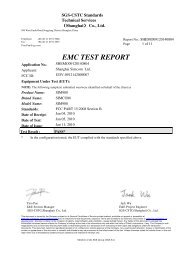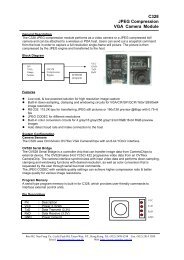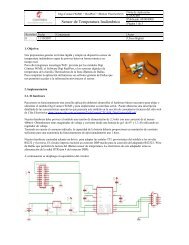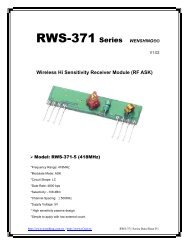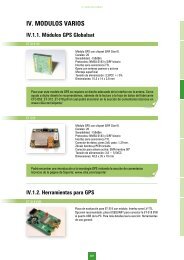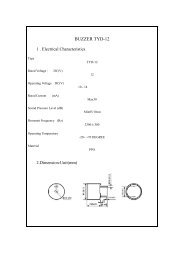Rabbit 2000™ Microprocessor
Rabbit 2000™ Microprocessor
Rabbit 2000™ Microprocessor
Create successful ePaper yourself
Turn your PDF publications into a flip-book with our unique Google optimized e-Paper software.
The Instruction Set<br />
The <strong>Rabbit</strong> 2000 features an updated<br />
Z180 style architecture improved<br />
for higher performance.<br />
A number of obsolete or redundant<br />
Z180 instructions have been<br />
dropped to allow efficient 1-byte<br />
operation-codes for new instructions.<br />
Existing Z180 assembly<br />
language can be ported to the<br />
<strong>Rabbit</strong> 2000 with minimal<br />
change.<br />
New C-friendly instructions are<br />
included for fetching and storing<br />
16-bit words located at a computed<br />
memory address or on the<br />
stack. New instructions perform<br />
fetches, stores, calls, returns and<br />
jumps over a full megabyte of address<br />
space.<br />
The new instructions improve<br />
communication between Z180<br />
registers, effectively enlarging the<br />
register set. Other new instructions<br />
provide 16-bit logical and<br />
arithmetic operations. Software<br />
floating point routines for add,<br />
subtract, and multiply require less<br />
than 12 microseconds at maximum<br />
clock speed.<br />
Memory access instructions can<br />
be turned into I/O access instructions<br />
by using a prefix. As a consequence,<br />
I/O access is faster and<br />
more flexible.<br />
The new instructions are natural<br />
improvements to the Z180 instructions,<br />
making a comfortable<br />
environment for the experienced<br />
Z80/Z180 assembly language programmer.<br />
Hardware Architecture<br />
Interrupt Structure<br />
Four levels of interrupt priority allow fast response to real-time<br />
events. Complete interrupt routines can execute in less than 4 microseconds.<br />
16-bit load and store I/O instructions improve I/O data<br />
transfer speed. Data transfer rates in excess of 250,000 bytes per second<br />
can be obtained using interrupts.<br />
Memory Management/Glueless Design<br />
• Three built-in memory chip select lines<br />
• Two memory chip output enable lines<br />
• Two memory chip write enable lines<br />
• Up to six static memory chips (RAM, flash) connect directly to<br />
the <strong>Rabbit</strong> 2000 without glue logic<br />
• Glueless architecture makes memory design much easier<br />
• One megabyte normal code space accessible directly by call and<br />
jump instructions<br />
• More memory is easily supported<br />
Figure 2, Example<br />
Processor Core using<br />
a <strong>Rabbit</strong> 2000<br />
<strong>Microprocessor</strong><br />
Battery Backup Feature<br />
The <strong>Rabbit</strong> 2000 has a special support feature<br />
for battery-backed RAM. In typical<br />
processors, a battery switch-over circuit<br />
maintains at least 2 volts of power to<br />
RAM and pulls the chip select line up to<br />
the same voltage as the battery. This<br />
method has a propagation delay often as<br />
much as 20 nanoseconds.<br />
The <strong>Rabbit</strong>'s special battery backup feature<br />
allows chip select #1 to be always<br />
forced low under program control, thus<br />
avoiding clock slow down. A hardware<br />
memory write-protect feature protects<br />
battery-backed RAM and flash memory<br />
from inadvertent write operations.<br />
Figure 1, Block Diagram of <strong>Rabbit</strong> 2000<br />
2



